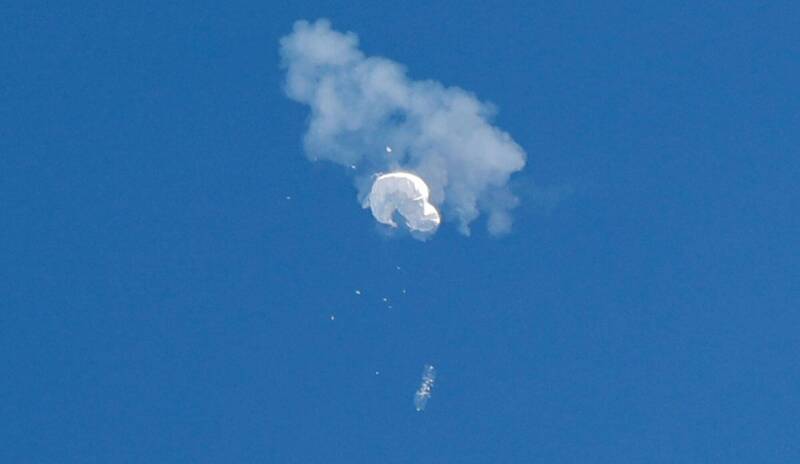A high-altitude balloon suspected of being a Chinese spy crossed North America, triggering a series of balloon disturbances. On the afternoon of the 4th, US Western Time, the US military dispatched F-22 fighter jets to launch AIM-9X Sidewinder missiles and shot it down off the coast of North Carolina. Shot down many suspected UFOs.
(Reuters file photo)
[Central News Agency] On the 1st of this month, a Chinese spy balloon invaded the sky over the state of Montana in the United States. On the same day, Washington quietly started negotiations with China. However, Americans were not the only ones who were greatly surprised by this. Chinese officials could not help but ask, "Who balloon"?
Up and down a confused, at a loss.
The "Wall Street Journal" (WSJ) reported that no one knew at the time how the balloon would quickly bring tensions to the already warming U.S.-China relations, becoming a new and ongoing point of friction.
Please read on...
The United States is still collecting information about the balloon, which was shot down by a U.S. warplane over the Atlantic Ocean on the 4th.
On the afternoon of the 12th, the U.S. military shot down a flying object over Lake Huron in Michigan near the U.S.-Canada border. This was the fourth such interception by U.S. warplanes in February.
U.S. officials said the Chinese spy balloons had stepped up surveillance of high-altitude airspace following the invasion.
A day before the Feb. 1 Washington meeting, the day before the Biden administration made public the spy balloon incident, senior foreign ministry officials in Beijing scrambled to check what the U.S. State Department had told Chinese diplomats, Chinese officials said.
The looming question, Chinese officials say, is: "Who really owns this balloon?"
The balloon incident surprised U.S. officials largely because it came at a time when China was working to improve relations.
Some officials in Beijing also referred to this event as a "black swan" (black swan) event, which no one could have predicted would happen.
According to the report, when Blinken and Deputy Secretary of State Wendy Sherman informed the charge d'affaires ad interim of the Chinese embassy in the United States Xu Xueyuan about the discovery of the Chinese balloon on the evening of the 1st, they found that the Chinese side also seemed to be confused about the matter.
State Department officials also told China that the Biden administration would issue a public statement on the matter.
According to people familiar with the matter, Xu Xueyuan and other Chinese embassy officials were greatly surprised by the US allegations.
After that, China’s foreign ministry coordinated a response with other agencies, which eventually led to a statement signed by Mr. Xi, according to Chinese officials with knowledge of the matter.
The statement said China regretted that the balloon was used for climate research and accidentally deviated from its course.
The Chinese Ministry of Foreign Affairs issued the above-mentioned statement on the morning of the 3rd, Washington time, that is, 36 hours after receiving the relevant notification.
"China has responded as soon as possible," the official said.
While the statement softened by Beijing's standards, it did not save Blinken's visit.
This is the second visit to China by a senior US official after five years of absence.
Although China claimed that the incident was accidental and due to force majeure, Washington did not pay the bill.
The U.S. believes the balloon is linked to the People’s Liberation Army, and the U.S. Navy, Coast Guard and FBI are all trying to locate and analyze Chinese surveillance equipment that was shot down off the coast of South Carolina.
U.S. officials have also admitted that they do not know whether Beijing intended to fly the balloon south over the heartland of the United States in the first place.
It would be a provocative move in the days leading up to Blinken's scheduled visit to China.
U.S. officials, however, believe the balloon, believed to have launched from Hainan Island, flew over the Aleutian Islands and Alaska under Chinese control.
Even if the strong winds carried the balloon further south than China expected, China appeared to be interested in using the flight to monitor sensitive U.S. military bases.
"The balloon was released on purpose, but its path was not planned," a U.S. official said.
U.S. officials said top Chinese and People's Liberation Army officials appeared confused about how to handle the matter, hampering Beijing's efforts to reset bilateral ties.
Both the U.S. and China want high-level exchanges before U.S. House of Representatives Speaker Kevin McCarthy's visit to Taiwan further strains U.S.-China relations.
Both sides must now grapple with heavy political pressure at home and try to avoid a rapid escalation of tensions.
The balloon incident also dampened the expectations of the outside world for the "rehearsal meeting".
Some Chinese officials had hoped that Blinken's trip would pave the way for a summit between Chinese and U.S. leaders.
The matter is also likely to be a major topic of discussion at the Munich Security Conference on February 17-19.
The debate over China's surveillance programs could damage Mr. Xi's efforts to break China's post-pandemic isolation.
According to Yun Sun, Director of the China Program at the Stimson Center, a think tank in Washington, "China still hopes to maintain some positive dynamics in the bilateral relationship."
"We haven't found a way out," the U.S. official said.
